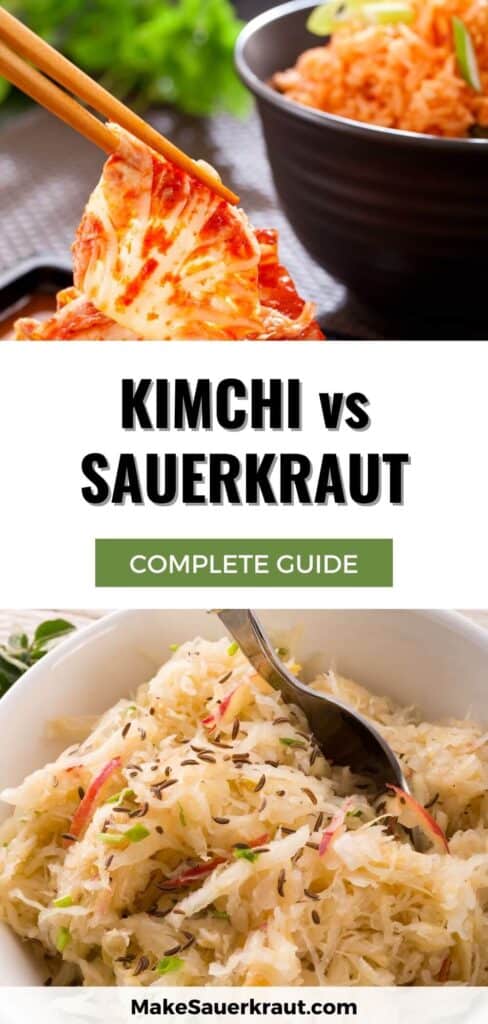Both kimchi and sauerkraut are made by fermenting cabbage but this is where the similarities end.
We have the deep red hue of kimchi vs. the thin, almost translucent shreds of sauerkraut.
For kimchi, napa cabbage cut into square, bit-sized chunks vs. sauerkraut, where green cabbage is cut into ribbon-like slices.
Kimchi is enjoyed daily at breakfast lunch and dinner whereas you’re lucky to get a random serving of sauerkraut on a hot dog.
So, what are the many differences between kimchi and sauerkraut?
What is kimchi?
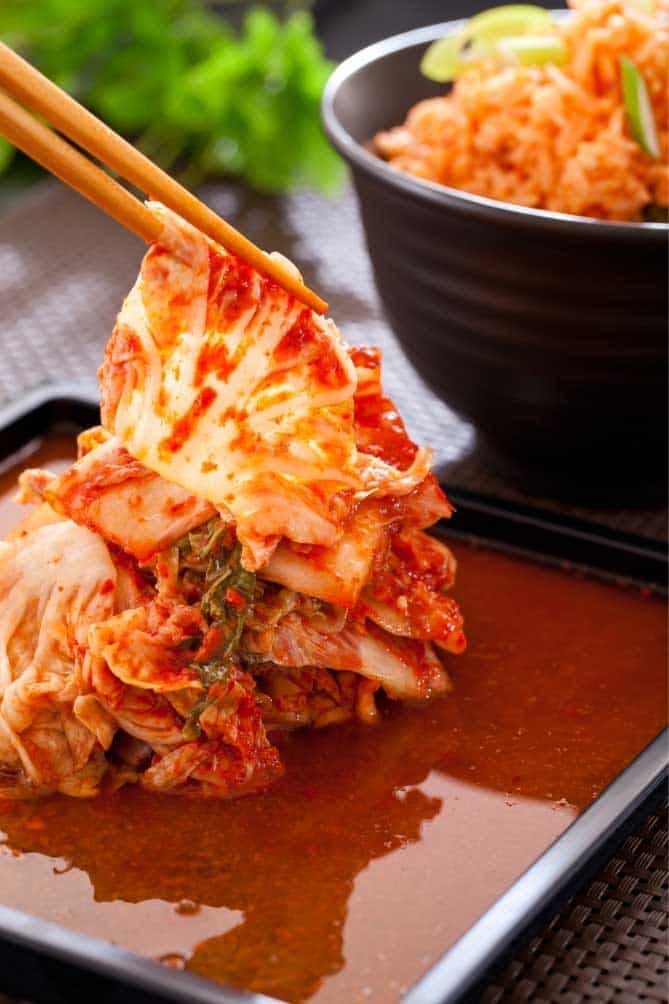
Kimchi is a collective term for vegetable dishes that have been salted, seasoned, and fermented. The tradition of making kimchi originated over 3,000 years ago and started as a way to preserve vegetables for the winter months.
The components for kimchi vary but usually include some combination of vegetables, garlic, ginger, red pepper powder, salt, and fish sauce. Cabbage is the most common vegetable used to make kimchi although carrots, radish, cucumber, and scallions are also frequently used.
There are actually over 200 varieties of kimchi, but the one we are most familiar with is Mak Kimchi or simple kimchi.
What is sauerkraut?
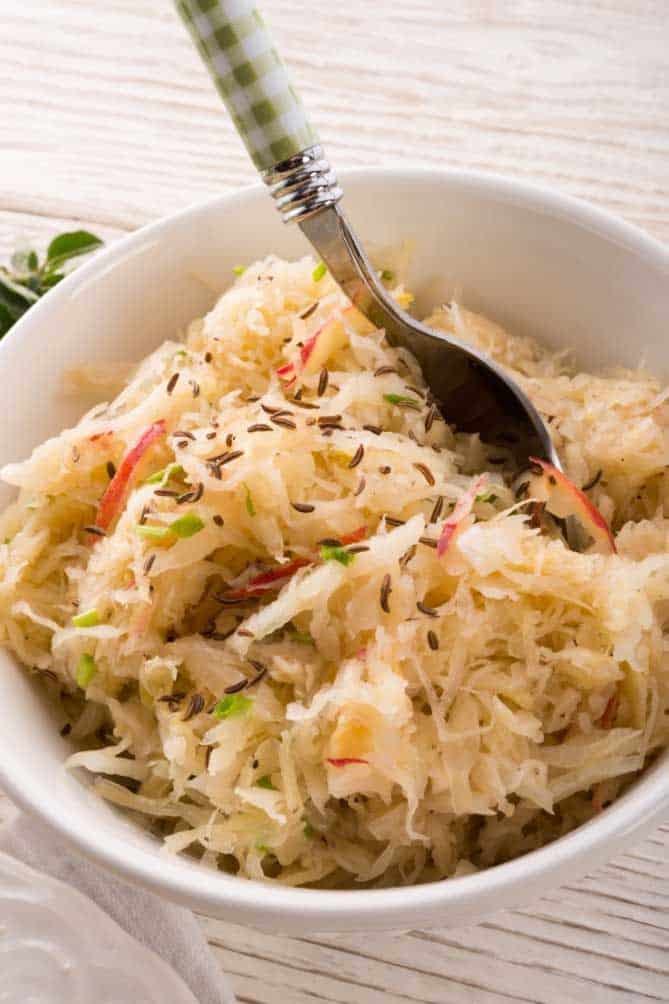
Sauerkraut is finely cut cabbage that has been fermented by various lactic acid bacteria. Properly stored, it has a long shelf life and a distinctive sour flavor, both of which result from the lactic acid that forms when the bacteria ferment the sugars in the cabbage.
Traditionally, sauerkraut was made with just cabbage, salt, and either caraway seeds or juniper berries. Today, one can buy or make sauerkraut that can include a wide array of flavoring ingredients from shredded carrots or beets to diced pineapple and turmeric powder.
What are the origins of these two popular fermented dishes?
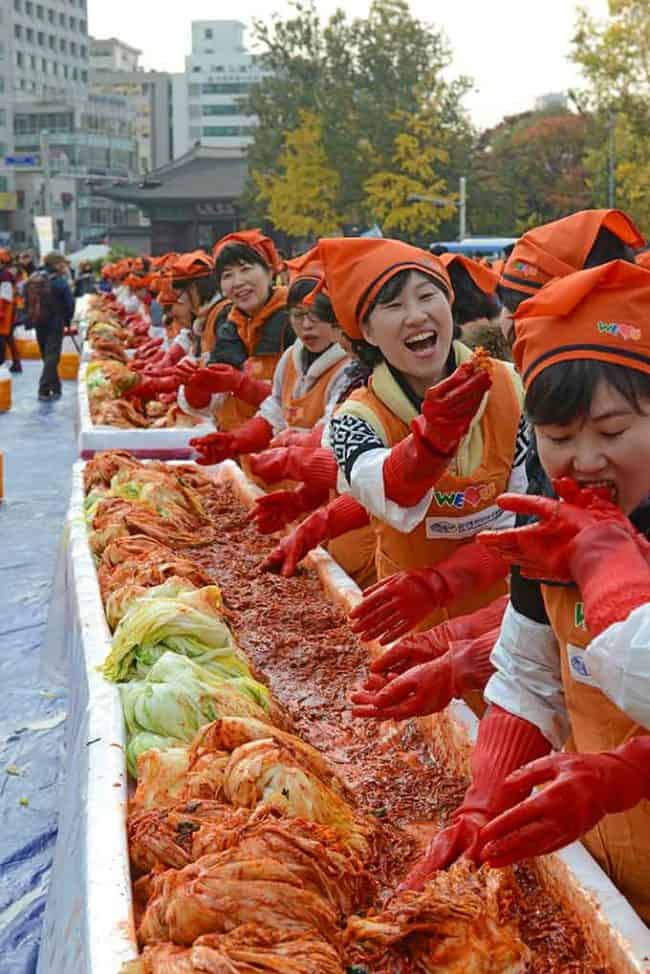

Kimchi history
The history of kimchi traces back to ancient times. References to kimchi exist as early as 2,600-3,000 years ago.
The first Chinese poetry book, ShiKyung, provides the first text-written evidence of its existence. In that book, the poet referred to kimchi as “Ji,” the term used before “Chimchae”. The earliest form of kimchi consisted only of salted vegetables.
In the twelfth-century people began to include other spices to create different flavors, such as sweet and sour savor, and colors of kimchi, such as white and orange.
Sauerkraut history
The Germans gave sauerkraut its popular name but the Germans did not invent sauerkraut.
Sauerkraut originated nearly 2,000 years ago in ancient China. In summer, slaves building the Great Wall of China lived on cabbage and rice. In winter, the cabbage was preserved with rice wine which soured the cabbage to keep thousands of laborers healthy in the worst of conditions.
The Tartars brought sauerkraut to Europe, where the recipe was improved upon. Rather than packing cabbage with rice wine, the Europeans packed the sliced cabbage in salt to give bacteria present on the cabbage the ability to convert the natural sugars into lactic acid, thus creating what we know today as sauerkraut.
Enjoy more fun facts about sauerkraut.
Cabbage Variety
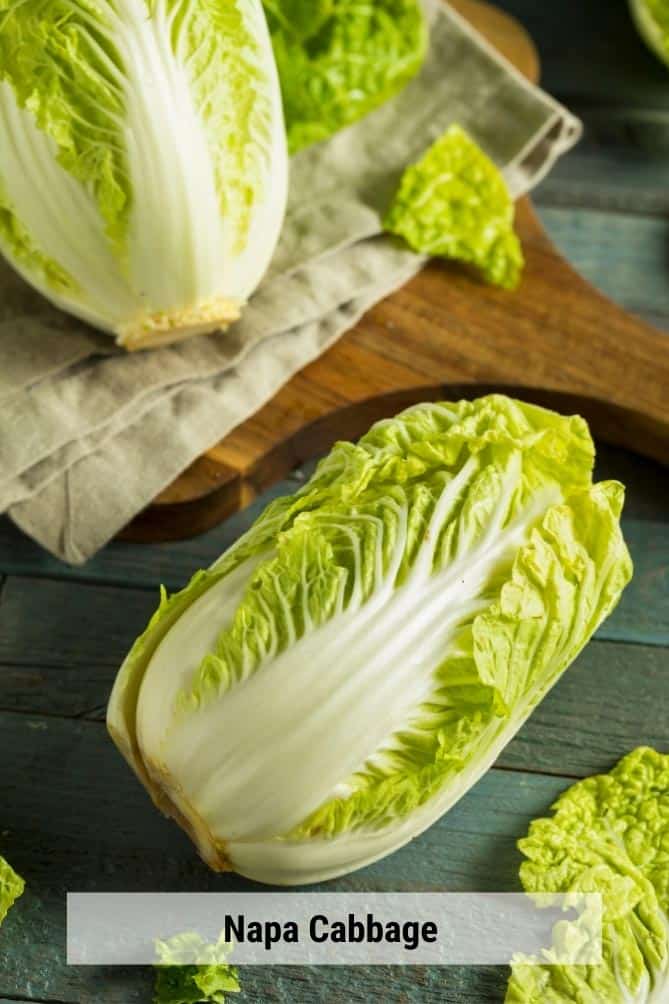
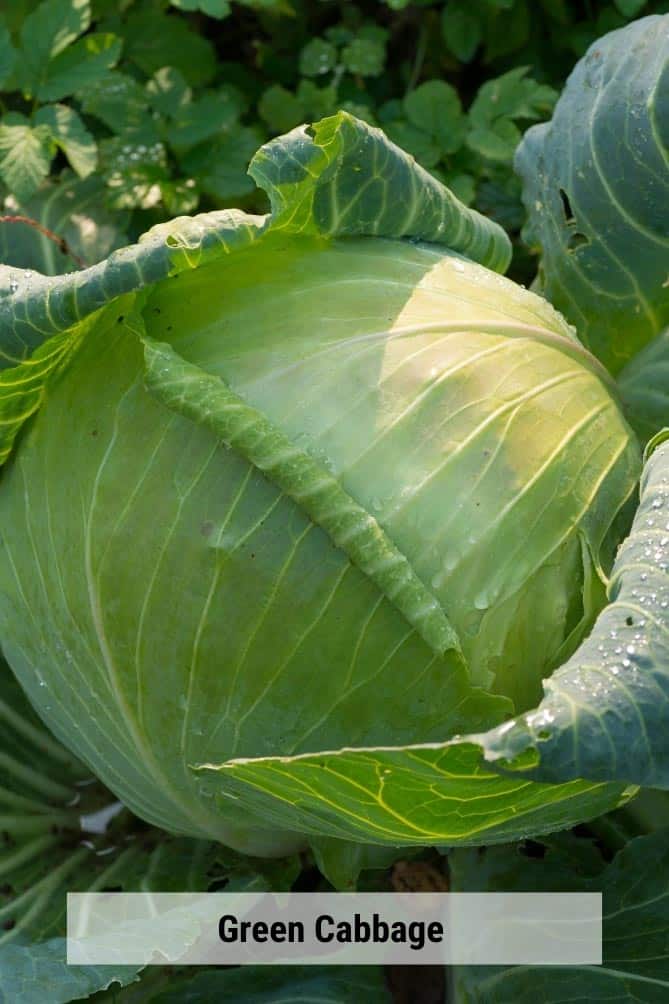
What type of cabbage is used to make kimchi?
Napa cabbage, also known as Chinese cabbage, is used to make kimchi.
Napa cabbage is a large-headed cabbage with firmly packed, crinkly, pale green, thickly veined leaves and a white stalk. It can be used whole, cut into quarters, or bite-sized cubes. The variety of kimchi being made will dictate the style of cut.
What type of cabbage is used to make sauerkraut?
Green cabbage, or white winter cabbage, is typically used to make sauerkraut.
Cabbage is a leafy green, red, or white plant grown as an annual vegetable crop for its tightly-packed heads. The best sauerkraut is made in the late fall using winter cabbage harvested after a few nights of hard frosts.
Green cabbage is quartered and then finely sliced using a cabbage shredder to quickly slice it into fine ribbons.
When you’re ready to make sauerkraut, use my cabbage buying guide.
Seasonings
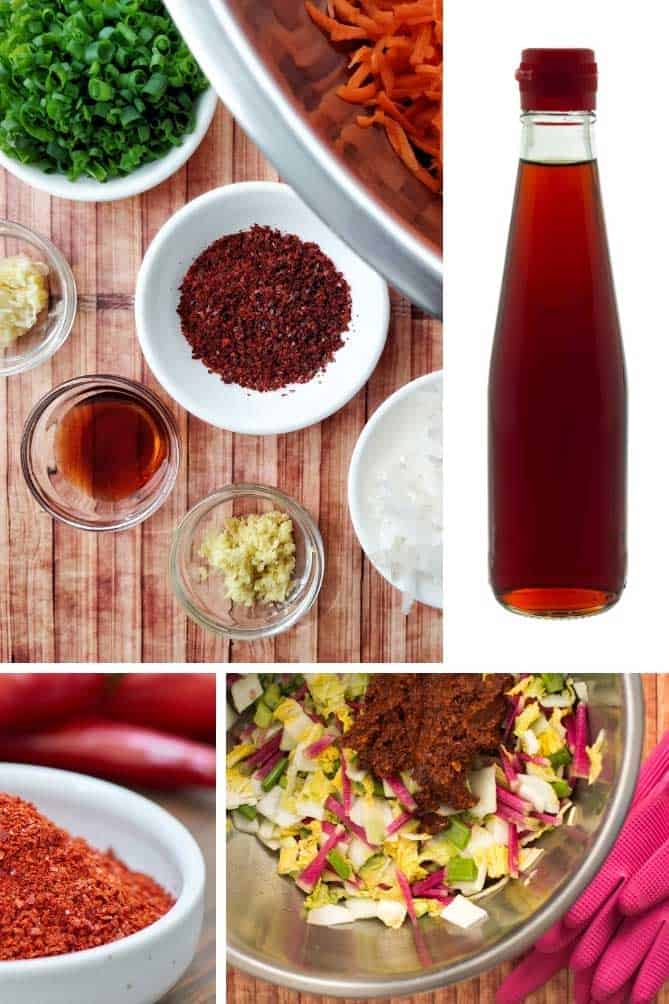
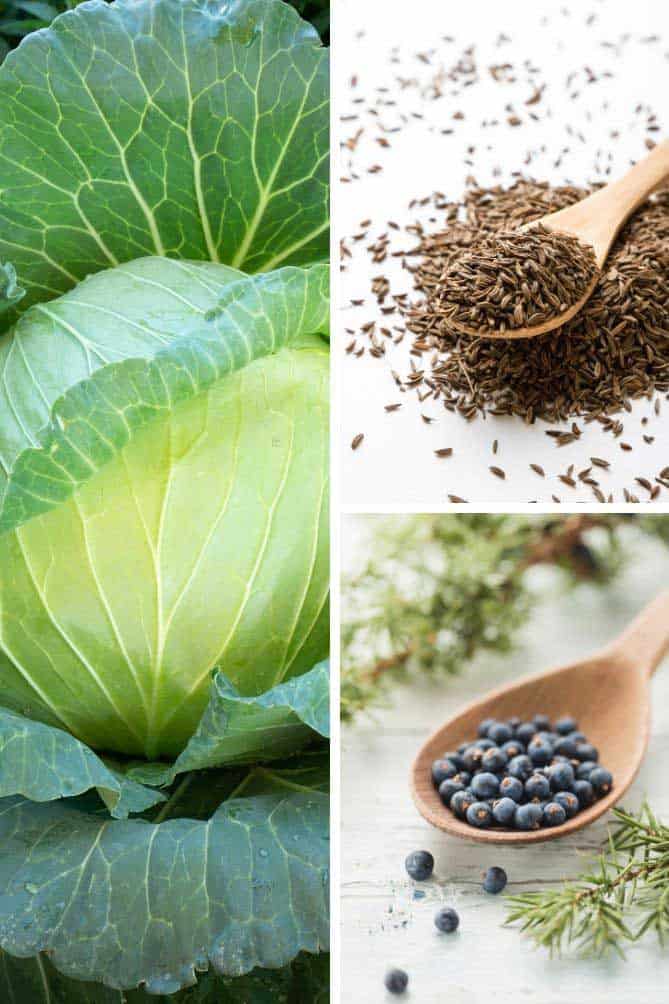
Ingredients for traditional napa cabbage kimchi
- Napa cabbage
- Daikon or Korean radish
- Onion
- Garlic
- Ginger
- Korean red pepper powder (gochugaru)
- Fish sauce
- Salted shrimp
- Rice flour
- White sugar
- Salt
A paste is made with rice flour and then pureed with onion, garlic, ginger, white sugar, Korean red pepper, fish sauce, and salted shrimp.
This paste is then mixed with the Napa cabbage and radish that has been first soaked in a salty brine. The rice paste ensures that the sauce adheres to the cabbage leaves. The white sugar adds extra food for the bacteria and helps to initiate the fermentation process.
The beautiful, orange-red hue of kimchi comes from gochugaru, or Korean red chili powder. It is not super spicy and hard to get the traditional flavors of kimchi without it.
The fish sauce and salted shrimp, both umami-rich flavoring ingredients add a depth of flavor unique to kimchi. There are substitutes, like miso paste, for making a vegetarian version.
Ingredients for traditional sauerkraut
- Green cabbage
- Caraway seeds and/or juniper berries
- Salt
The ingredients in traditional sauerkraut are fairly simple. Cabbage and salt with the addition of caraway seeds and/or juniper berries for flavoring.
Fermentation Vessel
Korean Traditional Onggi Pot
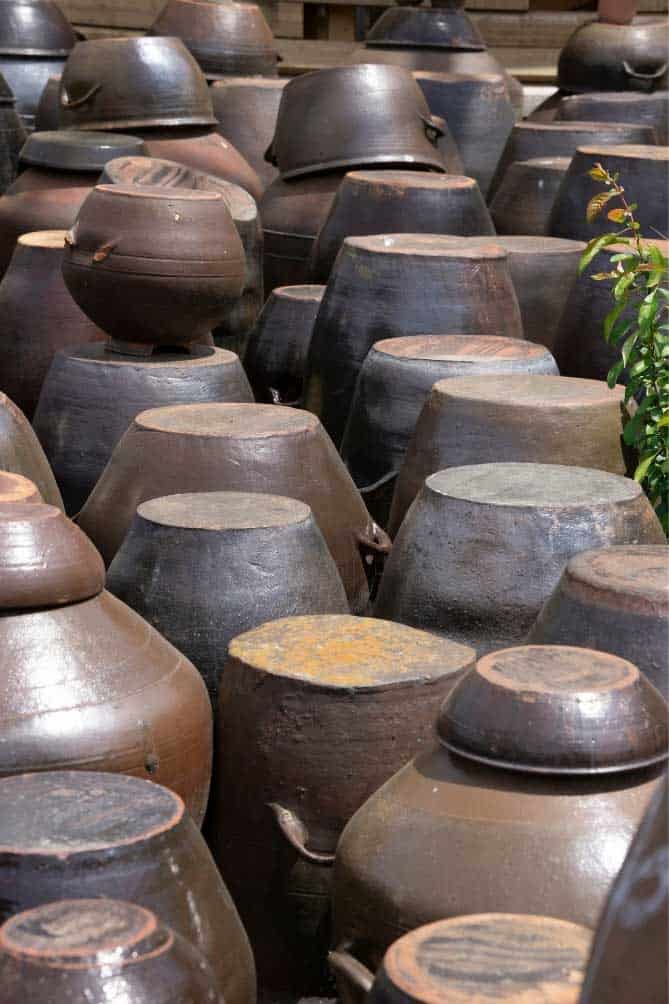
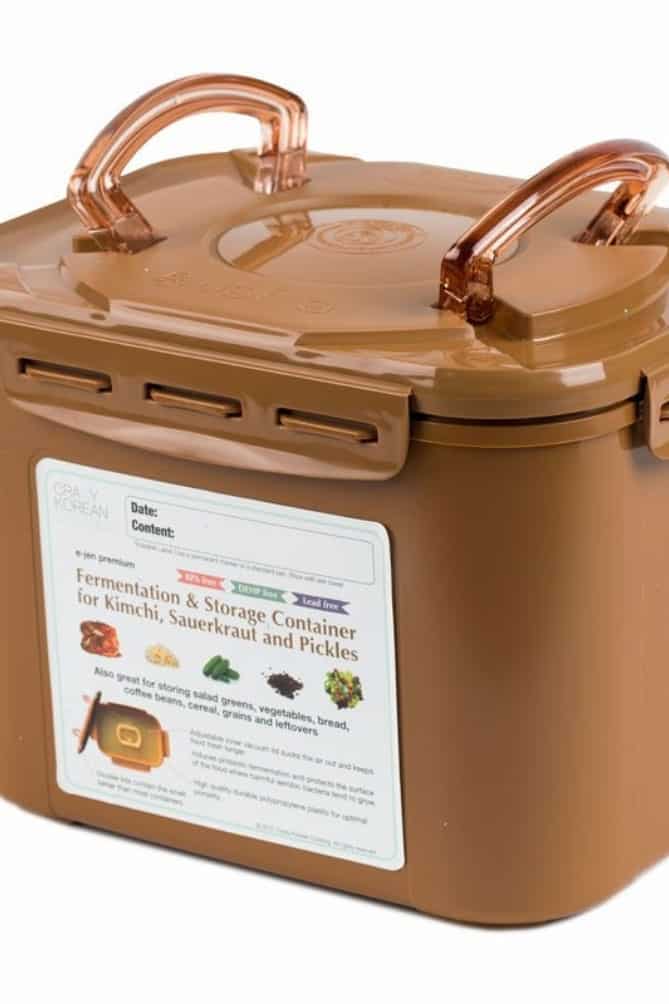
Kimchi was originally fermented in onggi pots partly buried in the cold earth in late autumn and winter.
Onggi pots are traditionally made from clay and sand but are now usually made from ceramic. They are fired in a kiln which leaves them with tiny pores. These tiny pores allow the kimchi inside the pot to breathe but making it watertight to achieve proper fermentation.
The concept of the original onggi is also available in a modern fermentation container. You can purchase kimchi fermentation containers made from food-safe plastic and a small percentage of natural clay to give them tiny pores like the original onggi pot.
Stoneware Fermentation Crock
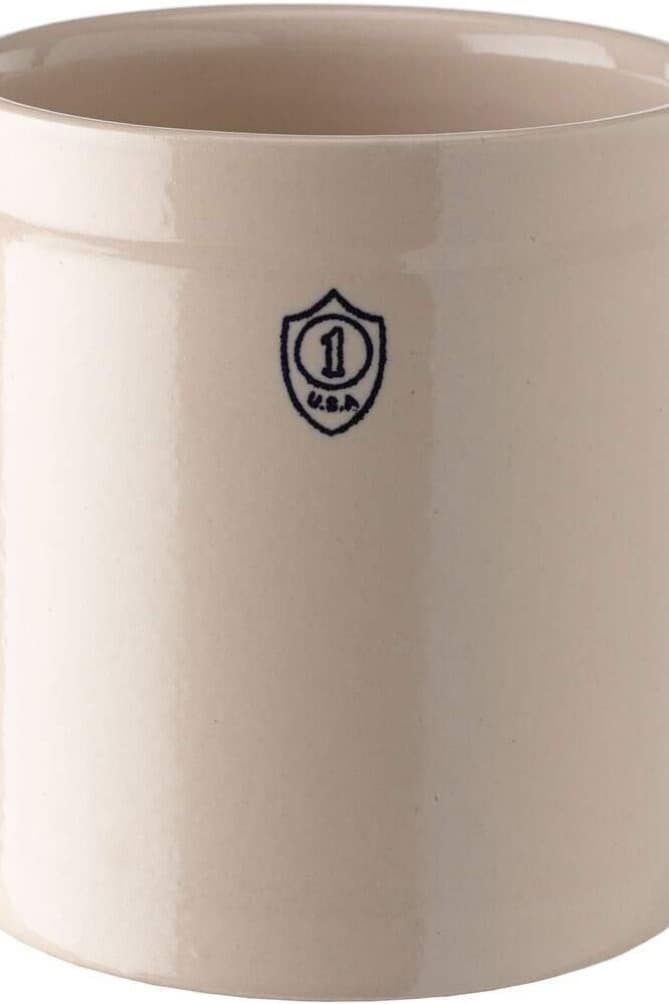
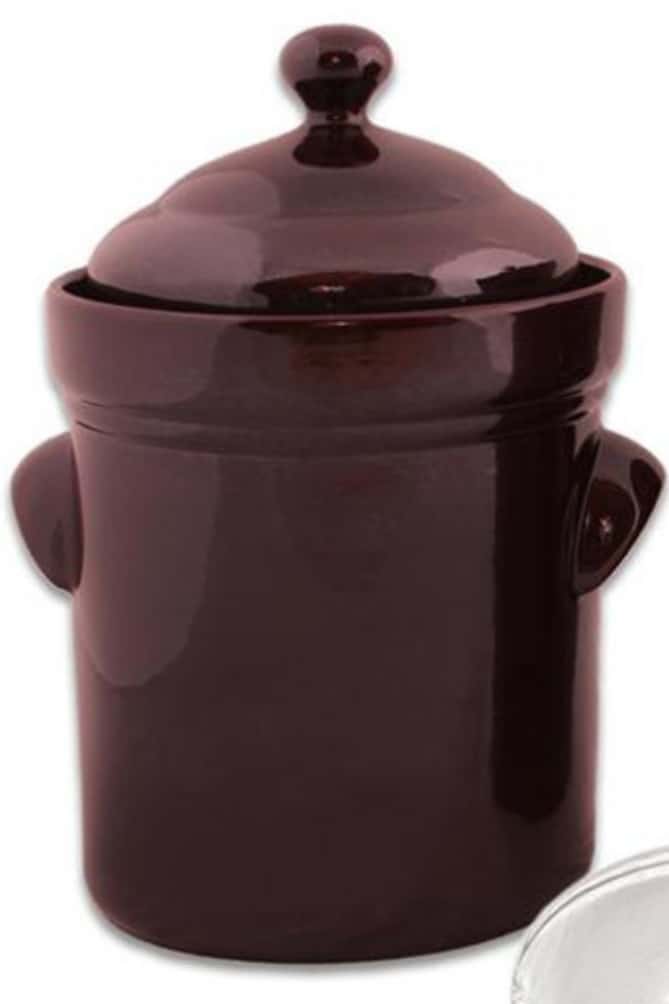
Traditionally, sauerkraut was fermented in open stoneware crocks, perhaps much like what your grandmother or great-grandmother may have fermented pickles in.
To ferment in an open crock, cabbage or vegetables are first packed into the crock and then a plate is placed in the crock—to hold whatever is fermenting below the brine. Lastly, a cloth is secured over the opening.
With this set-up, outside air can still enter the crock which often results in mold growing of the surface. The mold is removed, unearthing the fragrant, fresh-smelling sauerkraut.
We now have easy access to water-sealed crocks with a lid and moat that allow an air-tight seal to prevent mold gowth.
After a water-sealed crock is packed, two half-circle weights are placed into the crock to keep your ferment submerged. Then, the lid is placed into an open moat which is then filled with water.
Now, outside air is prevented from entering the crock, and carbon dioxide gases created during fermentation easily bubble out.
Method for Making
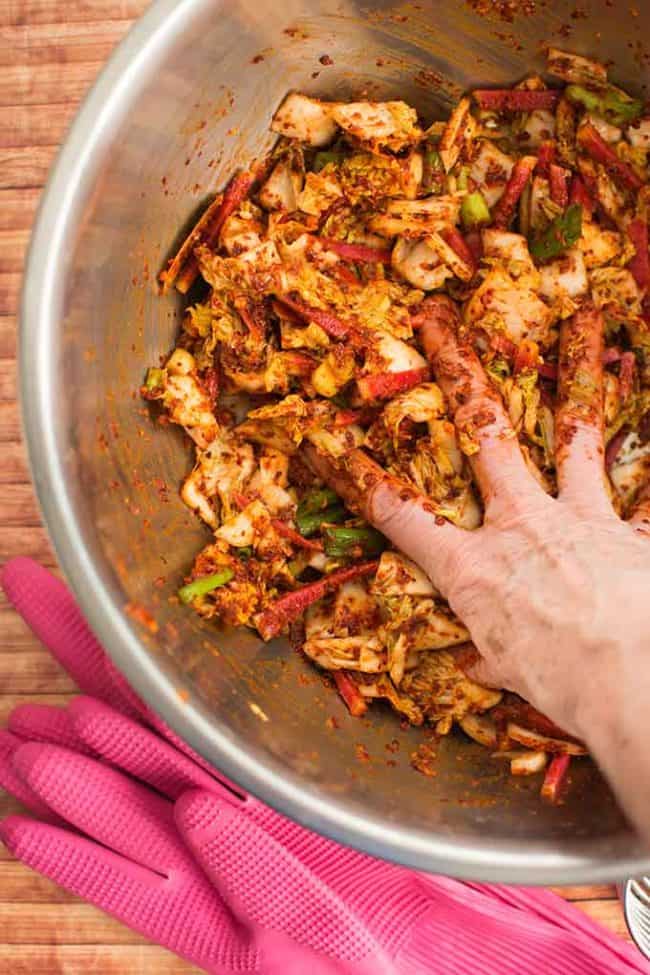
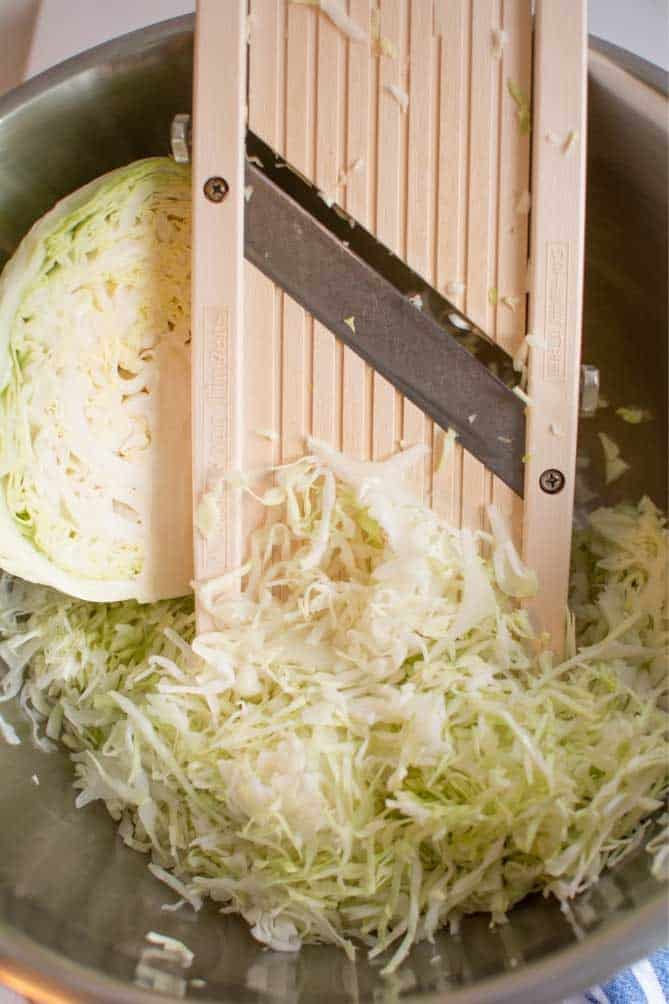
How is kimchi made?
To make Mak or simple kimchi, “square-cut” napa cabbage and julienned radishes are first soaked for a couple of hours in a simple brine.
A red pepper paste is made using thickened rice flour paste, ginger, garlic, sugar, Korean red pepper powder, fish sauce, and salted shrimp.
The cabbage and radishes are drained, mixed with the red pepper paste, and then packed into an onggi pot to ferment.
Kimchi is then fermented with more salt and at a significantly lower temperature than sauerkraut: 41F-57F for 1 to 3 weeks.
How is sauerkraut made?
Sauerkraut is made by thoroughly mixing thinly sliced green cabbage with salt. The salt pulls the water out of the cabbage cells to create a brine. This wet mixture is then packed into a crock.
Weights are added to hold the mixture below the brine after which it is left to ferment for 6 to 8 weeks in a cool cellar.
The traditional fermentation time for sauerkraut (in a large crock) is longer than for kimchi, lasting for up to 6-8 weeks and at a warmer temperature: 65F–75F.
Taste & Color
When ready, kimchi tastes like a crunchy pungent pickle that is less acidic but saltier than sauerkraut. The Korean red pepper powder gives it a beautiful red hue.
Sauerkraut is tangy tart and pale green or almost translucent in color.
These two special ferments add a depth of flavor to any meal: sauerkraut as a refreshing side dish, especially for rich meats. and kimchi for jazzing up bland rice (or consumed in one of these 35 simple ways.)
How much kimchi or sauerkraut is regularly eaten?
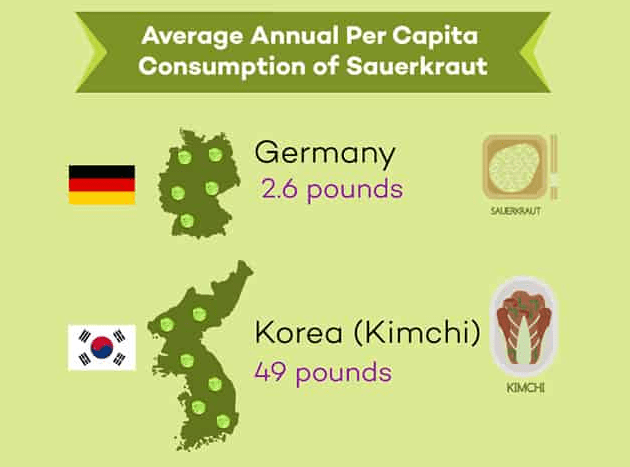
From my How Much Sauerkraut to Eat Daily? infographic, you can see that Korean’s far outpace the Germans in their per capita consumption of their traditional fermented food dish.
Why do the Koreans eat so much more kimchi than the rest of the world does sauerkraut?
For starters, this classic cabbage dish is usually served with breakfast, lunch, AND dinner. And, nowadays, kimchi has become so versatile that around two-thirds of Korean people eat kimchi every single day.
Is Kimchi Healthier than Sauerkraut
During the fermentation process for both kimchi and sauerkraut, billions of probiotics are created as the lactobacillus bacteria feed on the sugars in the vegetables and release lactic acid. These probiotics play a critical role in restoring the overall balance in your gut upon consumption.
According to Katherine Harmon Courage, author of Cultured, a single variety of kimchi might contain more than one hundred different types of microorganisms. And, a single gram of that fermented kimchi contains some 100 million lactic acid bacteria. Incredible!
Both rely on bacteria and yeast that live in symbiosis. In kimchi alone there is a list of some 10 lactobacillus including Lactobacillus kimchii. Some of them like Lactobacillus acidophilus are also found in Sauerkraut.
One reason for this greater diversity is the addition of other fermented ingredients, such as fish sauce and shrimp. In contrast, sauerkraut relies on only two primary ingredients.
But, don’t stop eating sauerkraut because it’s not quite as diverse. It is still a star player with countless nutritional benefits and numerous reasons to include this star of the fermentation world in your daily diet.
I’m of the firm belief that all fermented foods—with their microbial ecology—are good for you in the sense that we should be consistently educating our immune system with a range of beneficial bugs. I am a big fan of eating a diverse range of good bugs. Your immune system evolved for you to do that.
— David Mills, microbiologist, University of California at Davis
See this post for in-depth coverage of some common fermented foods to add to your daily diet.
How do you make kimchi or sauerkraut?
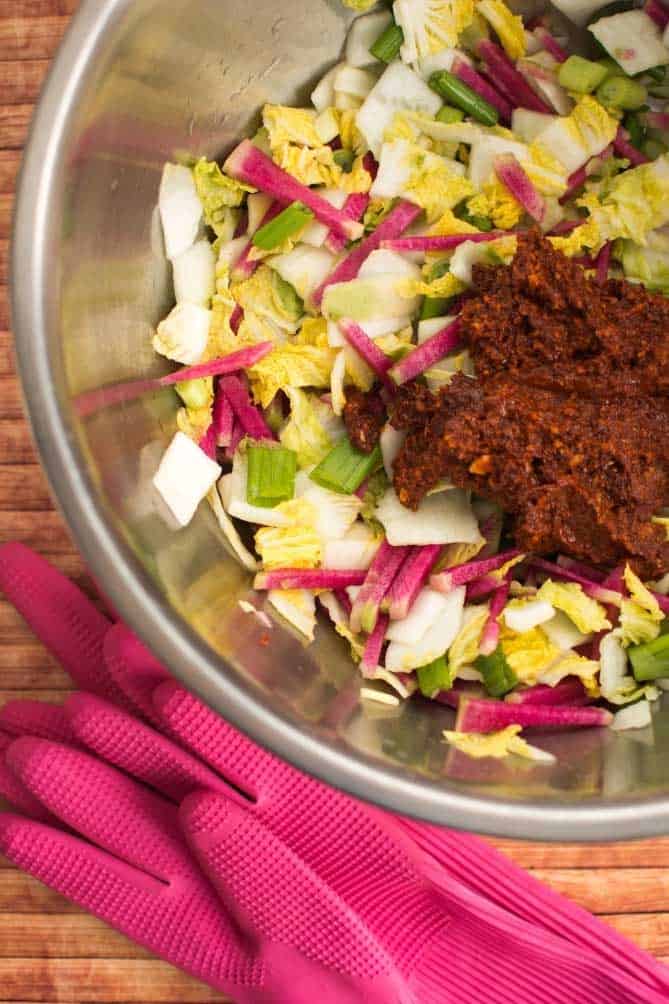
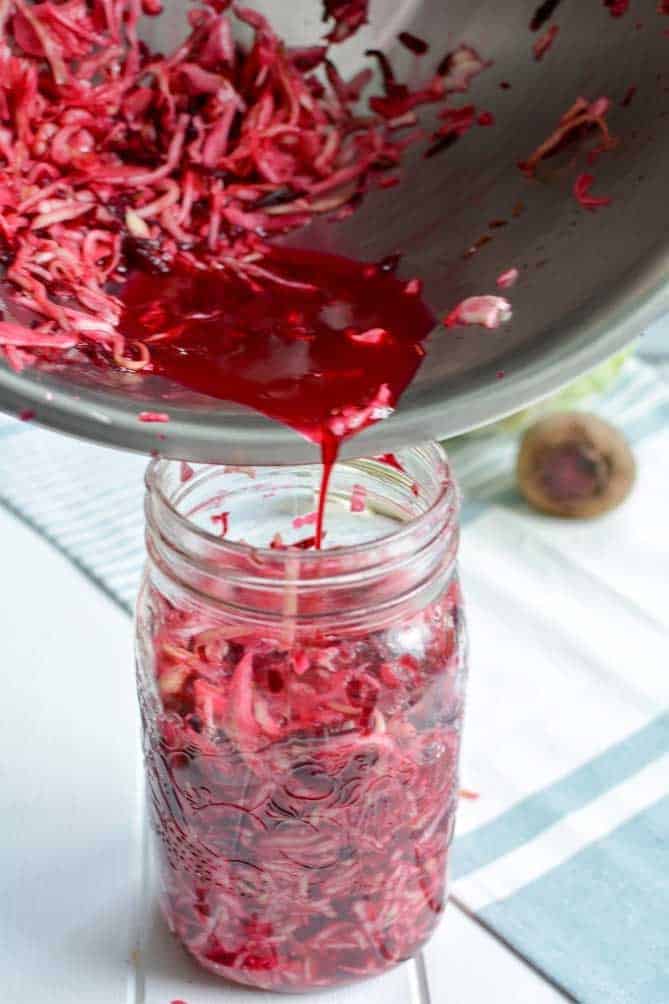
Beginners Guide to making kimchi
Many shy away from making kimchi thinking it’s too much work or are turned off by the pungent smells and noxious ingredients. That was certainly the case for me.
When I was in my late 20’s, a friend of mine had recently finished a Peace Corp’s stint in Korea and shared stories of one of his greatest challenges: learning to eat kimchi. Kimchi that was made with fermented fish! Yuck!
Once I learned the umami secret for the use of fish sauce in many kimchi recipes and then read that the fishy odors dissipate during fermentation, I was game to give it a try and developed my recipe for Traditional Square-Cut Napa Cabbage Kimchi. One taste of that and I was hooked.
I had also feared kimchi due to stories of its extra-spicy, uncomfortable heat due to all that red pepper in the various recipes.
Gochugaru, or Korean red chili powder, is actually less spicy than a jalapeno! Once I learned all the fascinating facts about gochugaru, and started fermenting with it, I was also hooked on this delectable, not-too-spicy chili powder. I now substitute it for all recipes that call for red pepper flakes, or similar hot spice.
To achieve the flavors of kimchi without soaking Napa cabbage leaves or making the red pepper paste try Brussels Sprout Kimchi or Kimchi-Style Sauerkraut.
Once you’re hooked on the depth of flavors in kimchi, stock your kimchi pantry and try Traditional Square-Cut Napa Cabbage Kimchi. You’ll be so glad you did!
Can I make vegetarian or vegan kimchi?
Yes. Omit the salted shrimp and substitute miso, or any of these vegan options, for fish sauce. Miso is high on the list of umami-rich foods and can deliver the same flavor punch as fish sauce.
Beginners Guide to making sauerkraut
Homemade sauerkraut tastes nothing like the stuff you buy in a can. All you need to get started is a quart (liter) jar, cabbage, salt, and…
an inexpensive digital scale. Like a bread baker weighing flour for success, a Fermentation Ninja weighs cabbage and salt to keep the bacteria that make fermentation happen happily working away.
Don’t worry about needing a special crock. Start with a small batch, learn the process, and enjoy this probiotic-rich, gut-healing food with your meals. It’s enough to get you hooked.
Explore six of my best fermentation tips that will give you the necessary foundation to become a Fermentation Ninja!
Understand what to look for when buying cabbage.
And, then use my step-by-step recipe to make a batch of mouthwatering sauerkraut.
Your belly will thank you. 😋


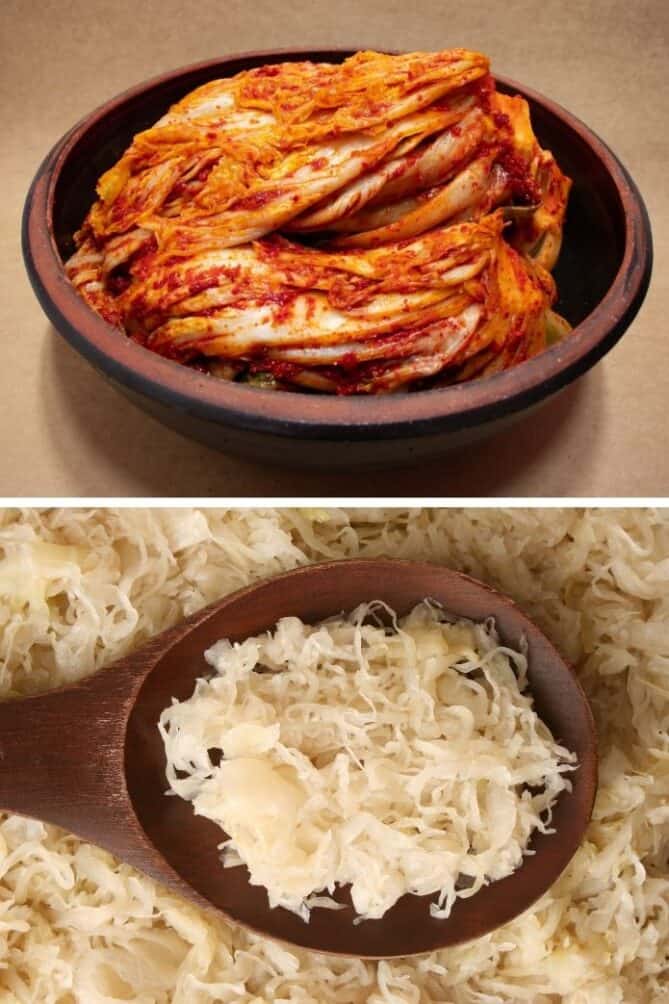

 This post may contain affiliate links which won’t change your price but will share some commission.
This post may contain affiliate links which won’t change your price but will share some commission.

